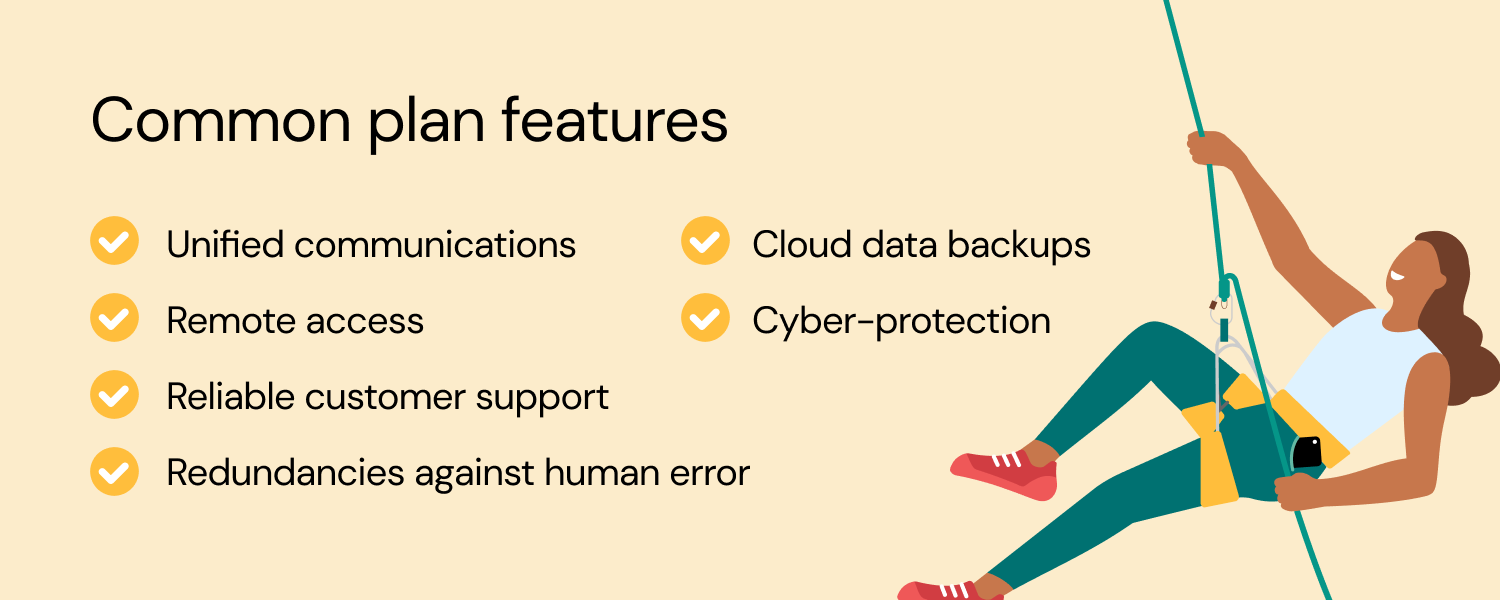In this article:
- What can affect your business operations?
- How can a business continuity plan help your business?
- Common mistakes to avoid in business contingency planning
- Create a clear plan to effectively manage remote workers
- Unified communications: a key business continuity feature
- Common features of a business continuity plan
- Create a customized business continuity plan with Sinch
In today’s marketplace, businesses are expected to support their customers at any time and even short business closures can affect your bottom line and reputation.
To avoid any service disruption and keep customers happy in any kind of circumstances, you need to expect the unexpected. This means having a solid plan and the right business communication services in place to give employees the flexibility to work from anywhere.
Let's examine what a strong business continuity plan should include to ensure your company can keep operations running smoothly in the face of a disaster or emergency.
What can affect your business operations?
As recent events have shown, many unforeseen events can disrupt operations and affect business continuity for weeks or even months — and that’s bad news for your bottom line if your business doesn’t have the right plan, systems, and procedures in place.
Global pandemics, hurricanes, tornadoes, and wildfires can force your employees out of the workplace for any amount of time. Natural disasters could also knock out your on-site infrastructure, or your business could be hit by a targeted cyber-attack — and the list goes on.
No matter if your company is a small business or a large enterprise, maintaining operations and service quality when the unexpected happens is crucial to retain customers and avoid any loss of revenue or reputation. And for this, you'll need a plan.
How can a business continuity plan help your business?
The best way to make sure your business remains operational is to invest in a business continuity plan.
A business continuity plan or disaster recovery plan is a strategy your company can fall back on when the unexpected happens. Whether it’s a natural disaster or a major global event such as a national health emergency, keeping your business running is crucial.
A business continuity plan takes advantage of modern technology to build a remote access network for your business. This allows your employees to work remotely when they can’t physically come into the workplace.
But how do you do it right, and what mistakes should you avoid?
Common mistakes to avoid in business contingency planning
From planning to implementation, managing your operational continuity plan isn’t always as straightforward as you might think. Here are a few common mistakes you should avoid:
-
Addressing unlikely risks: If your business isn’t located in an area typically affected by natural disasters, it probably isn’t worth putting too much effort into planning around them. You should look into issues which have a fairly good chance of affecting your business.
-
Relying too much on the plan: While a business continuity plan is a good backup strategy, it necessarily holds many redundancies to ensure your business can keep running. This means it’s probably more efficient to let your business run as normal in general and only fall back to the plan when necessary.
-
Having one keystone employee: For your backup plan to be effective, you should avoid putting too much weight on one person. Instead, make sure to have multiple people who can cover for each other in case one or more isn’t available.
-
Failing to keep your plan up to date: A business continuity plan must grow with your business to be effective. Check in on your plan once per quarter to make sure it still covers all the key components of your business.
-
Blocking incoming calls: When unexpected events occur, your business may need additional call capacity to handle a surge in customer calls. If your business uses SIP Trunking to carry phone connections over the Internet, “burstable” SIP Trunking is a good option to manage spikes in call demand, maintain your operational efficiency, and drive customer satisfaction. Bursting allows you to receive additional concurrent calls even though you may not have paid for enough paths to receive them.
-
Downplaying the need for mobility: Disruptions to your daily operations can happen quite suddenly and can affect your reputation, productivity, and revenue if you don’t have a plan to manage your communications from anywhere. Mobility has become a core part of almost every business, and with the right continuity plan, your mobility assets can act as a backup when an unplanned disruption occurs. You’ll need reliable communication channels and access to business-critical information to keep your team operational and your customers satisfied during an emergency or crisis.
-
Executing the plan poorly: Even the best plan will fail if it isn’t executed properly. Make sure all your employees are well-informed about your business continuity plan to avoid problems down the road. You should include your plan in your employees’ orientation. Running a drill to test your plan also helps ensure your systems are ready and allows you to make adjustments.

Create a clear plan to effectively manage remote workers
Managing a remote team has many great benefits, like attracting top talent around the globe and saving on real estate and other office expenses. Allowing remote work can also keep your business running in case of a natural disaster, health crisis, or other catastrophes. If you want to successfully manage a remote team, there are several things to consider to ensure your company’s productivity doesn’t miss a beat:
-
Set your team up for success by hiring the right people and training them well.
-
Make sure employees have the tools, access, and documents they need to work outside the office.
-
Encourage employees to treat the workday as if they’re in the office and establish a dedicated workspace free from distractions.
-
Check in frequently to keep your team supported and cohesive and encourage individual accountability. Holding team and 1-1 meetings consistently and communicating daily via messaging, video conferencing, email, and voice will help your team stay in touch and on top of deliverables.
-
Prevent loneliness and isolation by building rapport with everyone on your team — be responsive, engage regularly, make remote workers feel included in the organization, and cultivate an atmosphere of engagement and genuine connection.
-
Clearly communicate and focus on team and individual goals versus activity. Define accountability and output expectations and prioritize daily and weekly deliverables with employees.
-
Be aware of managing deadlines and group meetings within business hours across different time zones where remote workers are located.
-
Use technology to build community and invest in reliable tools to facilitate collaboration.
Unified communications: a key business continuity feature
The most effective business continuity plans include a unified communications service. This feature streamlines communications between employees to keep a company as efficient as possible.
Unified communications combine your business’s calling, audio conferencing, video conferencing, desktop sharing, file sharing, presence, messaging, and other communications methods. By giving your employees access to all of their business communications from one source, unified communications can drastically improve efficiency in the workplace.
When your employees aren’t able to work in the office, they can easily transition to working from home or a local coffee shop, making calls from their work phone number or communicating with colleagues over instant messaging just like on any other workday.
Unified communications put all of these key business features or apps into one easily accessible location for your employees, no matter where they are.
Common features of a business continuity plan
Business contingency plans typically include a whole range of features designed to keep your business running in the face of unexpected events, for instance:
-
Unified communications: As already mentioned, unified communication is key to an efficient workplace, both in terms of business continuity and general productivity. With a unified communications service set up for your business, your employees will be able to access all of their communications, including instant messages, calls, and video communications — from anywhere and at any time.
-
Remote access: Unified communications also allow employees to access your business network from any mobile device, making it the perfect way to improve efficiency both inside and outside of the workplace.
-
Reliable customer support: Companies with call centers need to be available at all times to troubleshoot customer problems and provide ongoing support and other customer-facing services. You may need to prepare your phone service to handle greater call volumes, increase call center queues, or allocate more staff to support customers.
-
Cyber-protection: Whether they steal your data or overload your servers cyber-attacks on businesses are getting more common every day. Protecting your business from cyber-attacks is therefore crucial.
-
Cloud data backups: In the event your company’s servers go down, you want your employees to be able to access your data remotely. Cloud data backups ensure your data is safe and accessible no matter what happens on-site.
-
Redundancies against human error: Oftentimes, major outages are caused not by an external event but by human error. If your systems are set up in the wrong way, a simple mistake by an employee can cause massive damage. Part of a business continuity package is to help instill redundancies in your business to prevent this from happening.
Create a customized business continuity plan with Sinch
In the long run, a business continuity plan saves your business a lot of time and money. If you don’t have a plan for disaster recovery in place for your company, consider investing in one.
Every business has unique aspects, and this is especially true when it comes to planning for disaster recovery and business continuity. Depending on how your company’s network and workplace are set up, different features will be necessary for keeping your business at its best. Whether you need to forward calls, quickly adjust your call handling capacity, adjust call queues, and more, Sinch can provide you with the tools you need to keep your business running — no matter what gets in the way.
Sinch offers access to industry-leading tools to support business continuity plans throughout the world. We’re here to assist you during uncertain times, when your disaster recovery plan needs to kick into high gear to maintain your company’s productivity. We offer solutions to quickly increase your concurrent call capacity over and above your current call paths and enable mobility when your employees need to work remotely unexpectedly.
If you want to learn more about incorporating unified communications into your business continuity plan, we’re here to help.



